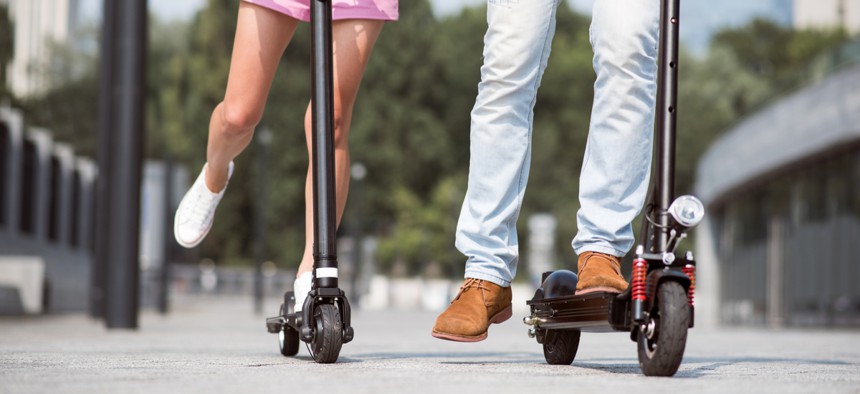Scooters Wouldn’t Be So Dangerous If You Just Wore a Helmet

Dmytro Zinkevych/Shutterstock.com
A much-anticipated CDC report on the safety of dockless electric scooters in Austin, Texas, finds an alarming percentage of head injuries after crashes.
At the annual Epidemic Intelligence Service conference in Atlanta this week, the Centers for Disease Control and Prevention presented findings from research on several public health scourges: Legionella, drug-resistant bacterial infections, the dreaded norovirus, and electric scooters.
The dangers posed by each of these threats varied widely. But they do have something in common: They’re mostly preventable. Avoid poorly maintained hot tubs. Don’t get weight loss surgery in Mexico. Wash your hands a lot. And, the CDC stresses, please wear a helmet.
The CDC began studying the public health impacts of dockless electric scooters soon after the tiny contraptions arrived on the streets of Austin, Texas, in April of 2018. The city’s transportation and public health agencies quickly noticed that a lot of people seemed to be falling off the vehicles, so they requested support to study the problem. The CDC sent four researchers to help launch the first epidemiological investigation into the safety of the micromobility revolution. In the 87-day study period, the CDC and Austin’s Public Health agency identified 271 riders with potential e-scooter-accident-related injuries, and interviewed more than half of them.
Their most striking findings: 45 percent of the incidents involved head injuries—and less than one percent of riders were wearing a helmet. Among those injured, 15 percent incurred “traumatic brain injuries.”
During the study period—from September 5 through November 30, 2018—a total of 936,110 e-scooter trips were taken in Austin, the study revealed, adding up to a total of 182,333 hours and 891,121 miles of e-scooter use. For every 100,000 trips taken, 20 individuals were injured.
“This study likely underestimates the prevalence of e-scooter related injuries,” the study states, because it focused on people who’d actually reported their falls. But it also may have over-indexed on seriousness, for the same reason. While only 14 percent of those injured were hospitalized, 88 percent were seen in an emergency room, and almost half reported a severe injury.
Of those injured, inexperience may have been a critical contributing factor: almost a third were first-time riders, and over 60 percent had been on a scooter nine times or less. “Maybe that’s not surprising: This is a new technology. They’re unfamiliar with it; they’ve never ridden it,” said Jeff Taylor, Austin’s lead epidemiologist. “It’s like the first time you take training wheels off your bike.” That suggests scooter safety rates will improve over time, as more riders hone their skills.
Better preparation would help, too. Though 60 percent of those interviewed said they’d looked at the in-app safety guidelines, “another injury prevention strategy is to explore training on safe scooter use,” said co-author Laurel Harduar Morano, part of the CDC National Institute for Occupational Safety and Health.
Other vehicles weren’t as major a factor in these types of accidents as you might think, researchers found. Cars and trucks kill 40,000 pedestrians a year (and took the lives of one biker and one pedestrian in just one week in D.C. last month). But in Austin, only 16 percent of incidents involved cars (colliding into them, swerving to avoid them, etc).
More critical was the condition of roadways. Half of those interviewed said infrastructure problems like potholes and pavement cracks contributed to their spills. Together, Austin’s downtown and the University of Texas at Austin were the sites of almost half the injuries. A third of the riders were injured on sidewalks, while 55 percent crashed on the streets.
Public-health hysteria surrounding scooter safety tends to spike after these kinds of reports are released. Bike accidents sends many riders to the ER, too, but since they’re not tech-ified or novel anymore, they get a lot less attention than scooters. When Portland, Oregon conducted its own analysis of scooter users in the city, they seemed to confirm the mismatch, finding that bicycles were involved in more trips to the emergency room than scooters over the same four-month period.
Another comprehensive study on scooter injuries in Santa Monica—where many scooter companies first launched their fleets—recorded 195 bike-related emergency room visits, compared to 249 scooter-related ones in the same year. Other findings from that study were consistent with Austin’s report: Only 4.4 percent of the injured L.A. riders wore helmets, and 40 percent of them reported head injuries.)
But such comparisons, says Harduar Morano, are “apples and oranges.” Scooters are often taken for short-term trips—in Austin, city data shows that the average trip distance was less than a mile—while bikers are on the roads longer. Because they’ve been around longer, there’s a much bigger user base, too.
“The time you’re on these vehicles and the time you have the potential for being injured is longer for bicycles than scooters,” said Harduar Morano. “So the comparison isn’t there.”
Even before the study was released this week, legislators in Texas have weighed legislation to regulate scooters in all its cities, citing them as a danger and a nuisance. On Wednesday, the state Senate approved a bill to ban them from the sidewalks and instate a minimum age requirement of 16. Now that legislation is moving to the House.
“As more of those findings are shared it will help all those groups—those [scooter] companies in particular, transportation departments, state health departments—in recognizing and identifying paths they can use to prevent injuries,” said Taylor. “We don’t want any measles cases, no sarcoidosis cases. To us, success is when we have zero people with illness. It’s the same with scooter-related injuries.”


